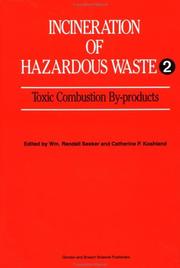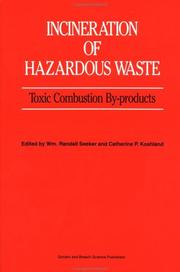| Listing 1 - 10 of 15 | << page >> |
Sort by
|
Book
ISBN: 0128205547 0128205539 9780128205532 9780128205549 Year: 2020 Publisher: Waltham, Massachusetts : Elsevier,
Abstract | Keywords | Export | Availability | Bookmark
 Loading...
Loading...Choose an application
- Reference Manager
- EndNote
- RefWorks (Direct export to RefWorks)
Soot. --- Black carbon (Soot) --- Dust
Book
ISBN: 1000005906 3866441037 Year: 2007 Publisher: KIT Scientific Publishing
Abstract | Keywords | Export | Availability | Bookmark
 Loading...
Loading...Choose an application
- Reference Manager
- EndNote
- RefWorks (Direct export to RefWorks)
The great challenge for next years concerning the emission of diesel engines is to develop diesel particle filters (DPF) with catalytic regeneration systems. This work is focused on the global understanding of the diesel soot oxidation on sintered metal filters (SMF). Platinum is studied as reference catalyst. The first objective is to determine which of platinum quantity, platinum particle size, or platinum location exhibits the preponderant influence on the catalytic.
platinum --- soot --- catalytic oxidation

ISBN: 2881246133 Year: 1994 Publisher: Yverdon : Gordon and Beach Science Publishers,
Abstract | Keywords | Export | Availability | Bookmark
 Loading...
Loading...Choose an application
- Reference Manager
- EndNote
- RefWorks (Direct export to RefWorks)
FLUE GASES --- HAZARDOUS WASTES --- SOOT --- INCINERATION
Book
ISBN: 1000045122 3731503301 Year: 2015 Publisher: KIT Scientific Publishing
Abstract | Keywords | Export | Availability | Bookmark
 Loading...
Loading...Choose an application
- Reference Manager
- EndNote
- RefWorks (Direct export to RefWorks)
Emission limits are being steadily tightened. This requires an ever increasing reduction of combustion generated pollutants. This book focuses on soot and NO and their heterogeneous interactions. With the help of laser spectroscopic methods and mathematical modeling of flames, a heterogeneous reaction mechanism for surface reactions can be validated and a significant influence on precursor reactions of soot formation can be shown.
Verbrennung --- Laserspektroskopie --- Oberflächenreaktioncombustion --- nitric oxide --- soot --- surface oxidation --- Stickoxid --- laser spectroscopy --- Ruß

ISBN: 288124517X Year: 1992 Publisher: Philadelphia : Gordon and Beach Science Publishers,
Abstract | Keywords | Export | Availability | Bookmark
 Loading...
Loading...Choose an application
- Reference Manager
- EndNote
- RefWorks (Direct export to RefWorks)
536.46 --- Flue gases --- -Hazardous wastes --- -Soot --- -Black carbon (Soot) --- Dust --- Hazardous waste disposal --- Poisonous wastes --- Toxic waste disposal --- Toxic waste release --- Toxic wastes --- Waste disposal --- Wastes, Hazardous --- Factory and trade waste --- Hazardous substances --- Refuse and refuse disposal --- Pollution --- Stack gases --- Combustion gases --- Combustion and similar reactions. Flames --- Congresses --- Incineration --- -Congresses --- -Combustion and similar reactions. Flames --- 536.46 Combustion and similar reactions. Flames --- -536.46 Combustion and similar reactions. Flames --- Black carbon (Soot) --- Hazardous wastes --- Soot --- Incineration&delete& --- FLUE GASES --- SOOT --- HAZARDOUS WASTES --- INCINERATION
Book
ISBN: 9283212932 Year: 2010 Publisher: Lyon, France International Agency for Research on Cancer ;
Abstract | Keywords | Export | Availability | Bookmark
 Loading...
Loading...Choose an application
- Reference Manager
- EndNote
- RefWorks (Direct export to RefWorks)
Carcinogens --- Gases, Asphyxiating and poisonous --- Soot --- Lungs --- Carcinogens, Environmental --- Inhalation Exposure --- Lung Neoplasms --- Talc --- Titanium --- Toxicology --- Dust diseases --- Tumors --- adverse effects --- chemically induced --- toxicity
Book
ISBN: 9781036401436 103640143X 9781527592971 1527592979 Year: 2024 Publisher: Newcastle upon Tyne : Cambridge Scholars Publishing,
Abstract | Keywords | Export | Availability | Bookmark
 Loading...
Loading...Choose an application
- Reference Manager
- EndNote
- RefWorks (Direct export to RefWorks)
Scientists often argue among themselves about the best description of nature. Science journalists, primarily reporters of scientists’ work, and facilitators of their arguments, sometimes go beyond reportage and actually join such arguments, or even initiate them. This book presents the story of such a case. In 1985, the first reports of the discovery of the spherical molecule C60 Buckminsterfullerene, a new third form of carbon beyond diamond and graphite appeared and excited the world, especially the science media. At about the same time, but with much less fanfare, a new description of the formation of the small carbon particles called soot emerged. As this book shows, Nobel laureates-to-be Rick Smalley, Harry Kroto, and Bob Curl sought acknowledgement as discoverers of C60 using the media skillfully. Rudy Baum, a correspondent and eventual editor for premier chemistry newsmagazine Chemical and Engineering News, helped promote and establish the validity of their claim not only by reporting it, but by linking it with the soot science world, evidently contriving an argument between physical chemists and combustion scientists. The soot formation modeler Michael Frenklach tried in vain to quash the notion of such an argument and Chemical and Engineering News never retracted Baum’s spectacular story of conflict.
Soot --- Buckminsterfullerene. --- Suie --- Buckminsterfullerène --- History --- History. --- Histoire. --- Histoire. --- Smalley, Richard E. --- Kroto, H. W. --- Smalley, Richard Errett, --- Kroto, Harold Walter, --- Curl, Robert F.,
Book
ISBN: 9783662464793 3662464780 9783662464786 3662464799 Year: 2015 Publisher: Berlin, Heidelberg : Springer Berlin Heidelberg : Imprint: Springer,
Abstract | Keywords | Export | Availability | Bookmark
 Loading...
Loading...Choose an application
- Reference Manager
- EndNote
- RefWorks (Direct export to RefWorks)
This thesis presents research focusing on the improvement of high-resolution global black carbon (BC) emission inventory and application in assessing the population exposure to ambient BC. A particular focus of the thesis is on the construction of a high-resolution (both spatial and sectorial) fuel consumption database, which is used to develop the emission inventory of black carbon. Above all, the author updates the global emission inventory of black carbon, a resource subsequently used to study the atmospheric transport of black carbon over Asia with the help of a high-resolution nested model. The thesis demonstrates that spatial bias in fuel consumption and BC emissions can be reduced by means of the sub-national disaggregation approach. Using the inventory and nested model, ambient BC concentrations can be better validated against observations. Lastly, it provides a complete uncertainty analysis of global black carbon emissions, and this uncertainty is taken into account in the atmospheric modeling, helping to better understand the role of black carbon in regional and global air pollution.
Environment. --- Atmospheric Protection/Air Quality Control/Air Pollution. --- Atmospheric Sciences. --- Climate Change. --- Environmental sciences. --- Climatic changes. --- Environmental protection. --- Sciences de l'environnement --- Climat --- Environnement --- Changements --- Protection --- Air -- Pollution. --- Atmosphere. --- Soot. --- Civil & Environmental Engineering --- Engineering & Applied Sciences --- Environmental Engineering --- Air --- Pollution. --- Air contaminants --- Air pollutants --- Air pollution --- Air pollution control --- Air toxics --- Airborne pollutants --- Atmosphere --- Contaminants, Air --- Control of air pollution --- Pollutants, Air --- Toxics, Air --- Black carbon (Soot) --- Pollution --- Control --- Atmospheric sciences. --- Climate change. --- Air pollution. --- Air quality --- Atmospheric deposition --- Dust --- Changes, Climatic --- Changes in climate --- Climate change --- Climate change science --- Climate changes --- Climate variations --- Climatic change --- Climatic changes --- Climatic fluctuations --- Climatic variations --- Global climate changes --- Global climatic changes --- Climatology --- Climate change mitigation --- Teleconnections (Climatology) --- Environmental quality management --- Protection of environment --- Environmental sciences --- Applied ecology --- Environmental engineering --- Environmental policy --- Environmental quality --- Environmental aspects --- Atmospheric sciences --- Earth sciences --- Global environmental change
Book
Year: 2020 Publisher: Basel, Switzerland MDPI - Multidisciplinary Digital Publishing Institute
Abstract | Keywords | Export | Availability | Bookmark
 Loading...
Loading...Choose an application
- Reference Manager
- EndNote
- RefWorks (Direct export to RefWorks)
Catalysts are made of nanoparticles of metals, metal oxides, and other compounds that may act as active phases, support the latter, or a combination of both. The initial incentive to reduce as much as possible, up to the nano-scale, the size of the particles of active catalyst components is to maximize the surface area exposed to reactants, thus minimizing the specific cost per function and increasing the rate of conversion of feedstocks to products in relatively simple reactions. Nowadays, the interest in nanocatalyst developments has shifted to an emphasis on improving the selectivity of catalysts, allowing one to obtain desirable reactions in more complex synthetic processes. Thus, new generations of nanocatalysts should be designed at the molecular level to display well-defined structural characteristics, in terms of size, shapes, hierarchical porosity, and morphologies, as well as with controlled chemical composition. The development of efficient nanocatalysts supposes the characterization of their various surface active sites at the nanometer scale, which is focused on establishing synthesis–structure–performance relationships.
Research & information: general --- plasmonic photocatalyst --- metal nanoparticle --- N–TiO2 --- nanocomposites --- photocatalytic selective oxidation --- heterogeneous catalysis --- transition metal nitrides --- hydrogen production --- formic acid decomposition --- nickel catalyst --- calcium oxide promoter --- silica support --- Iron-based perovskites --- copper --- NO oxidation to NO2 --- NO2-assisted diesel soot oxidation --- soot oxidation under GDI exhaust conditions --- aqueous-phase reforming --- nickel --- ceria --- zirconia --- calcium --- yttrium --- methanol --- graphite --- reduced graphene oxide --- nitrogen-doped reduced graphene oxide --- exfoliation --- oxygen reduction reaction --- electrocatalysis --- UiO-66 --- iron --- cobalt --- nanocatalyst --- CO oxidation --- COProx --- methane --- oxidation catalysis --- formaldehyde --- magnetite iron oxide --- Fe3O4 --- palladium --- Pd --- silver --- Ag --- low-temperature activity --- nanocomposite --- Raman --- TG in air --- TG in hydrogen --- XRD --- electron microscopy --- EDS --- coordination polymers --- methane storage --- XRD crystallinity measurements --- mechanical shaping --- compaction --- VAM --- gas separation --- MOF pelletization --- catalysts --- dimerization --- isobutene --- olefins
Book
Year: 2022 Publisher: Basel MDPI Books
Abstract | Keywords | Export | Availability | Bookmark
 Loading...
Loading...Choose an application
- Reference Manager
- EndNote
- RefWorks (Direct export to RefWorks)
This Special Issue will highlight the latest advances in numerical modeling of combustion-related applications. With the recent advancements in computational capacities and the widespread use of simulations in engineering problems, numerical methods are becoming increasingly important to improve existing models and develop new models that can help researchers to better understand the underlying mechanisms of combustion, their interaction with other physical phenomena, such as turbulence, and their impacts on the performance of related applications at both fundamental and practical levels.
Technology: general issues --- History of engineering & technology --- gas fire suppression --- inert gas agents --- agent quantity --- discharge rate --- ventilation rate --- premixed combustion --- obstructed channels --- flame acceleration --- thermal expansion --- computational simulations --- machine learning --- soot concentration --- soot emissions --- artificial neural network --- estimator --- computational fluid dynamics --- combustion --- biogas --- hydrogen --- laminar flame speed --- correlation --- jet-and-recirculation stabilized combustion --- OH* measurements --- numerical CFD analysis --- RANS modeling --- detailed chemistry schemes --- heat-loss modeling --- low-calorific combustion --- syngas fuel --- micro-combustion --- syngas --- repetitive extinction and ignition (FREI) --- numerical simulations --- flame instabilities --- flame propagation --- closed spherical bomb --- incipient stage --- methane --- N2O --- flash boiling --- gasoline direct injection --- Spray G --- discrete droplet method --- fuel surrogates --- combustion process --- reactivity model --- synthetic jet fuels --- turbine engines --- two-stroke engine --- multiple injection --- emission --- numerical simulation --- computational fluid dynamic (CFD) --- natural gas --- laminar burning velocity (LBV) --- closed vessel combustion --- numerical study --- microcombustion --- complex geometry
| Listing 1 - 10 of 15 | << page >> |
Sort by
|

 Search
Search Feedback
Feedback About UniCat
About UniCat  Help
Help News
News